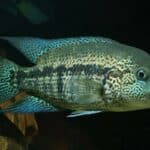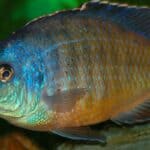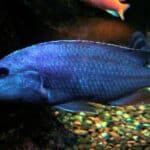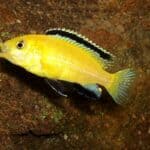The flowerhorn cichlid is a hybrid species of freshwater fish that cannot be found naturally in the wild. Born from the combination of the blood parrot cichlid and the red devil cichlid, this species has been bred exclusively in captivity since its conception and can be found in breeding farms across Thailand and Malaysia.

Since its initial creation, the flowerhorn cichlid has remained a popular species among enthusiasts and can now be found in aquariums across Asia, North America and Europe. Outside captivity, the species is considered incredibly evasive, with its presence in the wild often being the result of human intervention.
Care Guide
If you are now interested in purchasing a flowerhorn cichlid for your freshwater aquarium, then there are some important things that you need to consider.
Although the flowerhorn cichlid is not a challenging species to care for, they do require a certain level of care and have essential needs that must be met to ensure their health and comfort.
In the guide below, we are going to outline some key areas that you need to focus on when it comes to caring for your flowerhorn cichlid. By following these points, we hope that you will be able to provide your flowerhorn cichlid with everything they need to live a long and bountiful life.
Tank Size
When it comes to housing a flowerhorn cichlid, one of the most important things you need to consider is the size of the tank you are going to purchase.
If you are interested in owning a single flowerhorn cichlid, then the minimum recommended tank size will usually begin at 70-gallons, which will provide your flowerhorn cichlid with enough space to thrive and explore its surroundings.
Purchasing a decent-sized tank is incredibly important when it comes to caring for your flowerhorn cichlid, as the species is known to be very adventurous and will spend its days roaming around its enclosure.
By providing your flowerhorn cichlid with ample room, you can help to enrich the fish’s life while also ensuring it can swim and move comfortably around its tank.
Tank Mates
Like most members of the Cichlidae family, the flowerhorn cichlid is a species known for its territorial nature, which means it can exhibit aggressive behaviour towards other fish and even members of its own species.
Because of this, many enthusiasts prefer to keep their flowerhorn cichlids in single enclosures, as the species has been known to consume smaller tank mates and is perfectly capable of thriving in isolated environments.
If you are still interested in housing your flowerhorn cichlid with other tank mates, then there are some freshwater species that could fare better than others. However, there is always an added risk when it comes to introducing your flowerhorn cichlid to other fish, so you must remain watchful during the initial process.
Species that should be considered include:
- Oscar fish
- Plecos
- Bichir
- Big Cichlids
- Silver Arowana
- Bristlenose plecos
- Spotted hoplo catfish
Same Species Tanks
Although the practice of keeping multiple flowerhorn cichlids in the same tank is not impossible, it can be extremely difficult. As we previously mentioned, flowerhorn cichlids are highly territorial creatures, which means they are prone to aggressive behaviour and will often attack other members of their own species.
Because of this, it is often recommended that you house your flowerhorn cichlid in a single enclosure, as the species has been known to thrive in solitary conditions. However, if you are still keen to provide your flowerhorn cichlid with a tank mate, then another member of its own species is arguably the best choice.
When it comes to housing a pair of flowerhorn cichlids, you will need to purchase a tank that doubles the minimum recommended size that we previously discussed, as you need to provide both fish with enough room to explore while also ensuring that they do not invade each other’s chosen territories.
Water Parameters
When it comes to caring for your flowerhorn cichlid, you must make sure that the conditions inside your aquarium are suitable for the species, as this will help the fish to thrive while also reducing the chances of sickness and disease. Fortunately, the recommended water parameters for flowerhorn cichlids fit the standard of most tropical species.
- Water Temperature: 80-86 degrees Fahrenheit
- Ph Levels: 7-8 ph range (recommended)
- Water Hardness: 8-20 dGH
If you want to ensure the health of your flowerhorn cichlid, then you will also need to perform regular water checks, which will help to remove any unwanted nitrates from your aquarium.
What To Put In Their Tank
If you have ever seen a flowerhorn cichlid in a pet store or aquarium, then you may have noticed that the species is often housed in tanks that are bare or minimal. This is because some enthusiasts prefer to seek out maximum interaction with their fish, which can be easily facilitated by keeping them in empty tanks.
However, our personal preference is that the flowerhorn cichlid should be provided with additional sources of enrichment and entertainment. For example, the flowerhorn cichlid is known to root around in substrate, so we highly recommend filling your tank with soft materials that the fish can dig around in without issue or harm.
Beyond this, it is also advisable to avoid filling your aquarium with aquatic plants, as these could fall victim to the flowerhorn cichlid and its aggressive behaviour. Instead, you should adorn the tank with durable accessories such as rocks and driftwood, as this will provide a layered environment for the fish to explore.
Of course, it is also important to purchase an efficient filtration system that will maintain the cleanliness of the tank’s water, while also generating a moderate flow rate. Fortunately, flowerhorn cichlids do not require a certain amount of light, which means that any standard aquarium equipment will be enough to keep the fish satisfied and content.
Common Diseases
As a species, flowerhorn cichlids are considered very resilient in nature, which means they are not often prone to sickness or common diseases.
However, this does not mean that they are completely immune, as the fish can sometimes suffer from illnesses generated by low-quality water conditions such as hole-in-the-head diseases and ich. Fortunately, both of these diseases are treatable and can be easily abated by maintaining the cleanliness of your flowerhorn’s tank.
Food & Diet
When it comes to feeding your flowerhorn cichlid, there is a range of different foods that you can choose from. However, you will still need to make sure that you are feeding your fish a balanced diet of animal and plant matter.
For this reason, we personally recommend purchasing your flowerhorn some bloodworms or crickets, as these are a great source of protein and can be easily purchased from most pet stores and aquariums.
Beyond this, you will also need to provide your flowerhorn cichlid with the necessary nutrients it needs for the basis of its diet. Fortunately, this can be done by purchasing common fish food pellets from the local pet store, as they are a plant-based product and remain a popular choice among breeders and aquarists.
Some great foods that will keep your flowerhorn cichlid healthy include:
- Bloodworms
- Crickets
- Grasshoppers
- Worms
- Shrimps
- Crawfish (treat)
- Fish food pellets
Lifespan
In captivity, the average lifespan of a flowerhorn cichlid will usually range from eleven to twelve years, although some specimens have been known to live longer when housed in the correct conditions and fed a balanced diet of animal and plant matter.
This is something that you will need to consider before purchasing your own flowerhorn cichlid, as they are a species that require a lot of dedication and care.
Appearance
Flowerhorn cichlids are known to have a very distinctive appearance, with the species often exhibiting a large hump on its head and a slim, symmetrical body. Beyond this, the species can also be distinguished by its prominent fins and displays a lumpy chin that first made it popular among collectors.
However, the flowerhorn cichlid is primarily known for its vibrant color, with the most common variety of flowerhorn being the red dragon, which is known among enthusiasts for its bright pink-red hue.
Size
As a species, the flowerhorn cichlid has been known to reach lengths of 12-16 inches, with the males often being bigger in size than the females. Because of this, it is always important to purchase a tank that is suitable for the fish, as its size will often affect everything from how it is fed to the tank mates it should be housed with.
Behaviour & Temperament
As we have previously established, flowerhorn cichlids are considered to be a very aggressive species, which means they will attack other fish if the circumstances are right.
Typically, these attacks will be motivated by the flowerhorn’s territorial nature, which is why many aquarists recommend housing your fish in an isolated environment, with plenty of room for it to roam and explore its surroundings.
Although flowerhorn cichlids are known to be aggressive towards other fish, they can also be extremely friendly and playful when interacting with their owners, with some even exhibiting similar behaviour to that of a cat or dog.
However, this is not always the case and some specimens have been known to act aggressively towards all other lifeforms they encounter.
Breeding
If you are interested in breeding your own flowerhorn cichlids, then there are some obstacles that you need to overcome. The first and most important is that most flowerhorn cichlids are sterile, which means they are incapable of successfully reproducing.
Because of this, you will need to purchase two specimens that are capable of breeding, otherwise, you will be unable to begin the breeding process.
When breeding flowerhorn cichlids, you will need to move the potential pairing from their original tank and into a sufficient breeding tank, which should meet the same size requirements that we previously discussed.
The breeding tank will also double as the fry tank, which will help to make the overall process much more efficient, especially after the eggs have fully hatched.
Beyond this, the breeding tank will not need any special requirements or adjustments and should utilize the same water parameters that we previously outlined.
When the fry has hatched, you will need to feed them around five to ten times a day, while also ensuring that you are providing the necessary nutrients to promote growth and stimulation. This can be accomplished by feeding the fry live foods such as brine shrimp and other forms of shellfish.
Gender Differences: Male vs Female
Interestingly, there are new discernible differences between male and female flowerhorn cichlids, as both genders are known to exhibit the same features and behaviours used to distinguish the species.
The only noticeable difference between male and female flowerhorn cichlids is their size, with the males often being considered larger than their female counterparts.
Beyond this, male flowerhorn cichlids are also known to possess a more pronounced hump on their head, which can expand or shrink depending on the fish’s health and surroundings.
Fun Facts
- There are several flowerhorn cichlids currently available for purchase, including the Zhen Zhu, Thai Silk and Golden Monkey. However, the most common species among aquarists is the Red Dragon, which is the species you will most likely encounter in stores and farms.








